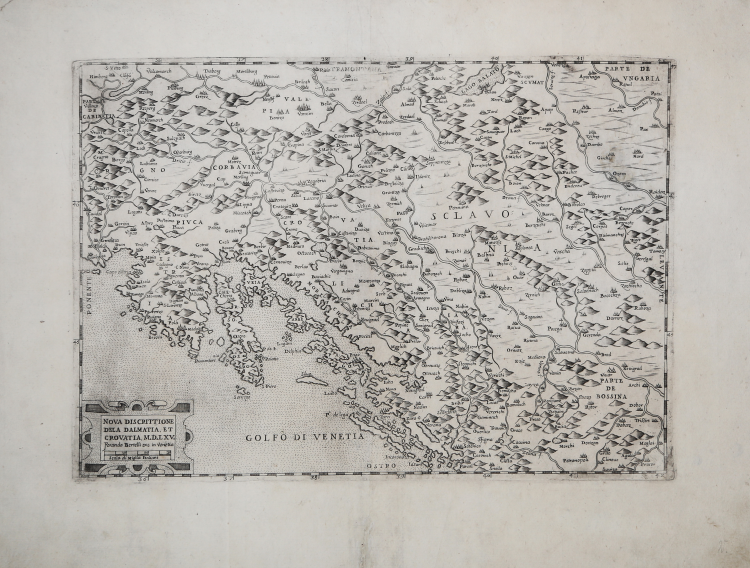




| Reference: | S39352 |
| Author | Paolo FORLANI |
| Year: | 1565 |
| Zone: | Dalmazia |
| Printed: | Venice |
| Measures: | 390 x 275 mm |



| Reference: | S39352 |
| Author | Paolo FORLANI |
| Year: | 1565 |
| Zone: | Dalmazia |
| Printed: | Venice |
| Measures: | 390 x 275 mm |
In an ornate cartouche placed in the lower left corner is the title: NOVA DISCRITTIONE DELA DALMATIA, ET CROVATIA. M.D.LXV. Ferando Bertelli exc in Venetia. Also in the cartouche is the Italian Mile Scale (30 miles, equal to mm 41). Orientation provided by the names of the winds in the sides in the center: TRAMONTANA, OSTRO, LEVANTE, PONENTE, north being at the top. Graduation in 6' margins, 44° to 47° latitude and 35° 12' to 42° longitude (35° 5' to 42° 6' side up).
The map depicts part of Friuli, Slovenia, Croatia, and part of Bosnia. Cartographically, it is derived from the Geographia particolare d'una gran parte dell'Europa, (1560) compiled by Giacomo Gastaldi, although Ferrando Bertelli refers to the NOVO DISSEGNO DELLA DALMATIA ET CROVATIA. M.D.L XIII that Giovanni Francesco Camocio published in 1563. David Woodward attributes the authorship of both engravings to Paolo Forlani.
“Only two years after Camocio’s original, Ferrando Bertelli published a replica of the 1563 map of Dalmatia, again based on Gastaldi’s model. Not particularly successful, it shows only slight stylistic differences and omission of the distinctive marks of the bishoprics in Camocio’s map. Woodward also attributes the engraving of this plate to Paolo Forlani. Judging by the considerable number of copies surveyed, Bertelli's map had greater editorial success than its prototype. Antonio Lafreri’s printer’s catalog (no. 40) lists a Dalmatia & Croatia that could be identified with this map, found in several sixteenth-century collections bearing the frontispiece Tavole Moderne di Geografia by the French publisher. It is plausible that Lafreri had some sort of right to the sale of the work for the city of Rome. A rare reprint by Francesco Valegio (1616) is known of this plate, which, in addition to variations in the cartouche, shows numerous changes in the toponymy. It was, in fact, updated with the addition of two important fortified cities that arose during the long war with the Ottoman Empire (1493-1593): Sisak (named Sicia) and Karlovac (named Carlista and founded in 1579)” (see Cartografia e topografia italiana del XVI secolo, p. 1326).
Etching and engraving, signed in plate in the cartouche at lower left by publisher Ferrando Bertelli. Example of the first state of two. Magnificent proof, printed on contemporary laid paper with watermark "mermaid in circle with six-pointed star (Woodward nn.91-92), with margins, in very good condition.
Bibliografia
S. Bifolco – F. Ronca, Cartografia e topografia italiana del XVI secolo, (2018), p. 1326, n. 587, I/II; Almagià (1927): n. 45; Meurer (2002): n. 42; Almagià (1929): tav. XXXV; Bifolco-Ronca (2014): n. 74; Cartografia Rara (1986): n. 37; Lago-Rossit (1981): tav. XXV; Lago (1994): p. 342, fig. 29 e p. 346, fig. 33; Lago (1998): n. 98 & 99; Novak (2005): p. 47, fig. 2; Tooley (1939): n. 188; Woodward (1990): n. 40.
Paolo FORLANI (Attivo a Venezia seconda metà del XVI secolo)
|
Paolo Forlani, a native of Verona, opened his own chalcographic workshop in Venice, Al segno del pozzo, in 1560, as reflected in some of his works. From 1566 he was active in Merzaria al segno della colonna and from 1569 in Merzaria al segno della nave. Forlani had business relationships with the major publishers of cartographic material of the time, among them Antonio Lafreri, the Bertelli family, and others. In addition to being a talented engraver, he was also quick to execute, a quality that enabled him to work for different publishers at the same time, and to execute a large amount of work. Woodward attributes about one hundred works to Forlani, most of which, however, are unsigned. Between 1560 and 1567, Forlani collaborated with Ferrando Bertelli, for whom he engraved about ten copperplates, with Camocio, Bolognino Zaltieri, and with Claudio Duchetti, for whom he engraved some maps. For his professional activity, however, the collaboration with Giacomo Gastaldi, for whom he engraved thirteen maps, was very important and valuable. In 1567 Forlani published and traded his work Il primo libro delle città et fortezze principali del mondo, whose branches later passed to Bolognino Zaltieri. It is likely that Forlani died during the plague that spread through Venice from 1575.
|
Paolo FORLANI (Attivo a Venezia seconda metà del XVI secolo)
|
Paolo Forlani, a native of Verona, opened his own chalcographic workshop in Venice, Al segno del pozzo, in 1560, as reflected in some of his works. From 1566 he was active in Merzaria al segno della colonna and from 1569 in Merzaria al segno della nave. Forlani had business relationships with the major publishers of cartographic material of the time, among them Antonio Lafreri, the Bertelli family, and others. In addition to being a talented engraver, he was also quick to execute, a quality that enabled him to work for different publishers at the same time, and to execute a large amount of work. Woodward attributes about one hundred works to Forlani, most of which, however, are unsigned. Between 1560 and 1567, Forlani collaborated with Ferrando Bertelli, for whom he engraved about ten copperplates, with Camocio, Bolognino Zaltieri, and with Claudio Duchetti, for whom he engraved some maps. For his professional activity, however, the collaboration with Giacomo Gastaldi, for whom he engraved thirteen maps, was very important and valuable. In 1567 Forlani published and traded his work Il primo libro delle città et fortezze principali del mondo, whose branches later passed to Bolognino Zaltieri. It is likely that Forlani died during the plague that spread through Venice from 1575.
|